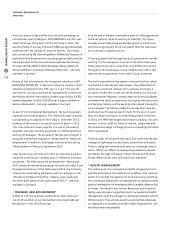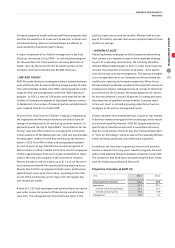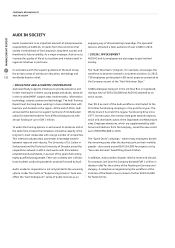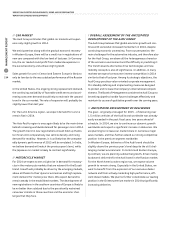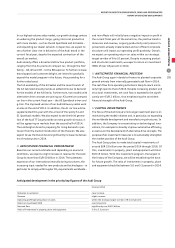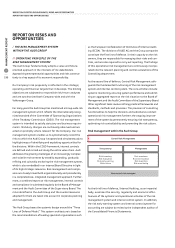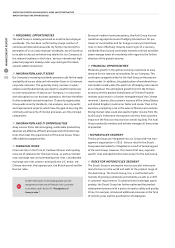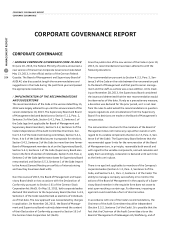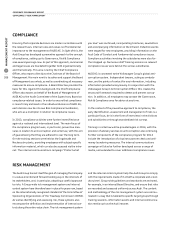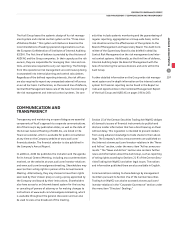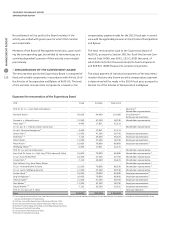Audi 2013 Annual Report Download - page 203
Download and view the complete annual report
Please find page 203 of the 2013 Audi annual report below. You can navigate through the pages in the report by either clicking on the pages listed below, or by using the keyword search tool below to find specific information within the annual report.
REPORT ON EXPECTED DEVELOPMENTS, RISKS AND OPPORTUNITIES
REPORT ON RISKS AND OPPORTUNITIES
MANAGEMENT REPORT
200
A
By steadily building on our worldwide market presence and con-
sistently increasing our innovativeness, we prepare the ground
for realizing these opportunities. In addition, the further inter-
nationalization of our production network enhances not only
our flexibility, but also strengthens worldwide awareness of
our brand.
//
INDUSTRY RISKS
Continuing socio-political change is heightening the need for
sustainability and a responsible approach towards society and
nature. For the automotive industry, the need to reduce fuel
consumption and vehicle emissions, but also generally to meet
sustainability requirements is particularly in the spotlight, not
least in view of the worldwide debate about CO2 limits.
As one of the leading premium suppliers, Audi fully embraces
its entrepreneurial responsibility and has defined sustainability
of products and processes as a key strategic goal. Attainment of
that goal rests in the hands of a department created especially
for this purpose and is being pursued with a view to economic,
ecological and social responsibility. We responded to the needs
of our stakeholders for us to disclose transparent goals and
sustainability activities by publishing our first Corporate Respon-
sibility Report in 2013.
Our corporate bodies have the fundamental task of systemati-
cally examining decisions about products and processes for
environmental and social compatibility. In this context, we
already play a leading role in the industry with the early devel-
opment and introduction of fuel efficiency technologies for
conventional combustion engines. We are known for our exten-
sive product range featuring high-efficiency, progressive vehicle
concepts that use technologies from the modular efficiency
platform. In addition, there are alternative forms of drive such
as electric and hybrid vehicles that represent a central compo-
nent of our strategy of diversified drive principles. We hold
regular stakeholder dialogues to gauge the current and future
sustainability requirements of all our interest groups.
Coupled with the industry’s development worldwide, there is
evidence of intensifying competition including in the form of
sales promotional measures. The price policies of direct com-
petitors and the increased use of sales incentives could lead to
price erosion or inflated marketing costs for the automotive
industry. Such a trend would also adversely affect the Audi Group
and correspondingly reduce its revenue and profit. Our brand
strength and attractive product portfolio help to keep these
risks in check.
The Audi Group uses its motorsport activities in particular to
test technical innovations. We counter the risks associated
with motorsport through technical precision in development
and production, as well as through safety-related and legal
safeguards.
//
INDUSTRY OPPORTUNITIES
Rising standards of sustainability and efficiency required from
a regulatory and social perspective can also offer market oppor-
tunities for an innovative company such as Audi. As well as
improving conventional drive technologies, we are putting con-
siderable effort into the development of plug-in hybrid drives
and all-electric drive types. Growing digitization and connectiv-
ity also mean there is ample scope for connectivity services
and driver assistance systems that enhance convenience.
//
RISKS FROM OPERATING ACTIVITIES
The product development cycles in the automotive industry
involve high upfront expenditure in the form of development
costs and capital investments in future projects. Yet the pay-
back period for this upfront expenditure stretches over several
years, reflecting the life cycle of the products. This presents
the fundamental risk that the financial target figures will not
be achieved due to outdated planning assumptions, deadline
overruns, deviations in quality or short-term changes in cus-
tomer expectations.
The Audi Group addresses this problem by conducting an exten-
sive analysis of the environment and customers when defining
new products. In addition, the product creation process incorpo-
rates an ongoing calculation of costs and revenues in the form
of a product profitability analysis, as well as diverse manage-
ment and control tools to assure the intended degree of project
maturity. To guarantee enduring customer delight and economic
success, target/actual analyses are conducted on an ongoing
basis, with corresponding escalation processes all the way up to
top management. This ensures that preventive countermea-
sures are identified wherever financial and technical project
risks exist. It is not possible to guarantee the market success
of new vehicle projects, technologies or services completely,
even after extensive market studies and with thorough project
planning and management.


